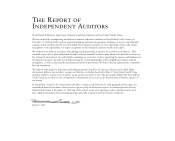Navy Federal Credit Union 2006 Annual Report Download - page 26
Download and view the complete annual report
Please find page 26 of the 2006 Navy Federal Credit Union annual report below. You can navigate through the pages in the report by either clicking on the pages listed below, or by using the keyword search tool below to find specific information within the annual report.
15
14
e anticipated employer contribution in 2007 is $25 mil-
lion for the pension plan and $643,000 for the postretire-
ment benefit plan. e accumulated benefit obligation for
the pension plan was $337 million and $303 million at
December 31, 2006 and 2005, respectively.
e measurement date for the pension and postretirement
benefit plan in 2006 and 2005 was December 31.
Navy Federal’s pension plan asset allocations by asset
category for 2006 and 2005 and the target allocations
for 2006 were as follows:
Navy Federal employs a total return investment approach
whereby a mix of equities and fixed income investments
are used to maximize the long-term return of plan assets
for a prudent level of risk. e intent of this strategy is to
minimize plan expenses by outperforming plan liabilities
over the long run. Risk tolerance is established through
careful consideration of plan liabilities, plan funded status,
and corporate financial condition. e investment portfolio
contains a diversified blend of equity and fixed income
investments. Investment risk is measured and monitored
on an ongoing basis through annual liability measurements,
periodic asset/liability studies, and quarterly investment
portfolio reviews.
Navy Federal 401(k) Savings Plan
is is a defined contribution plan where employees can
contribute pre-tax money to a 401(k) retirement account
and receive employer matching contributions. e matching
contributions are based on participation in a defined benefit
retirement plan. Employees participating in the Cash
Balance Plan receive a 100% employer match on the first
6% of pay they contribute to their 401(k) account, and
employees participating in the Traditional Plan receive
an employer match of 50% on the first 6% of pay they
contribute to their 401(k) account.
e cost recognized for the 401(k) Plan including matching
contributions and administrative costs was $8.44 million
and $6.89 million for the years ended December 31, 2006
and 2005, respectively.
Deferred Compensation Plan (457)
is is a non-qualified deferred compensation plan as
allowed under Internal Revenue Code Section 457(b). is
plan offers a before-tax savings opportunity to highly-
compensated employees in the Executive and Professional
compensation programs. e annual deferral amount
allowed mirrors the 401(k) plan and contributions are
held by Navy Federal and earn monthly interest based
on Navy Federal’s gross income for the month divided
by the average earnings on assets (loans and investments)
for the month.
Non-Qualified Supplemental Retirement Plan (SERP)
is non-qualified plan is designed to “make up” for benefits
not paid through the defined benefit retirement plan as a
result of limitations imposed by the IRS. e Internal
Revenue Code Section 401(a)(17) limits the amount
of compensation that can be used in the defined benefit
retirement plan’s annuity calculation and Internal Revenue
Code Section 415 limits the amount of monthly annuity
that can be paid by the defined benefit retirement plan.
All benefits are paid from the plan trust. Navy Federal
makes all contributions to the trust in accordance with the
company’s funding policy and in compliance with all federal
laws and regulations.
Navy Federal accrued $2.19 million and $1.44 million to cover
this expense at December 31, 2006 and 2005, respectively.
N : R P
T
In the normal course of business, Navy Federal extends
loans to credit union officials. e total principal amount at
December 31, 2006 and 2005 was $27.1 million and $22.1
million, respectively. Credit union officials are defined as
volunteer members of the Board of Directors and board
committees, and employees with the title of Vice President
and above.
N : M
In May 2006, Gulfport CBC Credit Union was merged
into Navy Federal. Navy Federal accounted for this
merger using the pooling-of-interests method described
in Accounting Principles Board Opinion No. 16, Business
Combinations. As a result of this merger, Navy Federal
obtained $1.5 million in equity.
N : R
U E
Navy Federal is subject to regulatory capital requirements
administered by the NCUA. Failure to meet minimum
capital requirements can initiate certain mandatory—
and possibly additional discretionary—actions by regulators
that, if undertaken, could have a direct material effect on
Navy Federal’s consolidated financial statements. Under
capital adequacy regulations and the regulatory framework
for prompt corrective action, Navy Federal must meet
specific capital requirements that involve quantitative
measures of Navy Federal’s assets, liabilities and certain
commitments as calculated under generally accepted
accounting principles. Navy Federal’s capital amounts
and net worth classification are also subject to qualitative
judgments by the regulators about components, risk
weightings and other factors.
Quantitative measures established by regulation to ensure
capital adequacy require Navy Federal to maintain minimum
amounts and ratios of net worth to total assets. Credit unions
are also required to calculate a risk-based net worth (RBNW)
requirement that establishes whether the credit union will
be considered “complex” under the regulatory framework.
Navy Federal’s RBNW requirement as of December 31,
2006, was 5.36%, which is less than the regulatory threshold
of 6% that would place Navy Federal in the “complex”
category. Management believes, as of December 31, 2006,
that Navy Federal met all RBNW capital adequacy
requirements to which it is subject.
e NCUA categorized Navy Federal as “well capitalized”
under the regulatory framework for prompt corrective
action with a net worth to assets ratio of 11.56% and
10.92% as of December 31, 2006 and 2005, respectively.
Net worth for this calculation is defined as undivided earn-
ings plus regular and capital reserves. To be categorized as
“well capitalized,” Navy Federal must maintain a minimum
net worth ratio of 7% of assets. ere are no conditions or
events since that notification that management believes have
changed the institution’s category.
e following is a comparison between Navy Federal’s
actual net worth and the minimum net worth required to
be “well capitalized” (dollars in millions at year end):
N : F V
F I
Navy Federal discloses fair value information of its financial
instruments, whether or not recognized in the Consolidated
Statements of Financial Condition, for which it is practicable
to estimate that value. In cases where quoted market prices
are not available, fair values are based on estimates using
present value or other valuation techniques. ose tech-
niques are significantly affected by the assumptions used,
including the discount rate and estimates of future cash
flows. In that regard, the derived fair value cannot be
substantiated by comparison to independent markets and,
in many cases, could not be realized in immediate settlement
of the instrument. Certain financial instruments and all
non-financial instruments are excluded from disclosure
requirements. Accordingly, the aggregate fair value amounts
presented do not necessarily represent the underlying fair
value of Navy Federal. e following methods and assump-
tions were used in estimating the fair value disclosures for
financial instruments:
Loans to Members
For certain residential mortgages, fair value is estimated
using the quoted market prices for securities backed by
similar loans. e fair value of other types of loans, such as
consumer and equity loans, is estimated by discounting the
future cash flows using the current market rates at which
similar loans would be made to borrowers with similar
credit ratings and for the same remaining maturities.
Investments, Including Mortgage-backed Securities
Fair value is based on quoted market price, if available. If a
quoted market price is not available, fair value is estimated
using quoted market prices for similar securities. For resale
and repurchase agreements, due to their short-term nature,
the carrying amount is a reasonable estimate of fair value.
Cash and Cash Equivalents
Cash and cash equivalents include cash and balances due
from banks, federal funds sold and securities purchased
under agreements to resell, all of which mature within
ninety days. e carrying amount reported approximates
fair value for vault cash and demand balances from other
financial institutions. Fair value for short-term securities is
based on quoted market prices.
Members’ Accounts
e fair value of Share Savings, Money Market Savings,
Checking and Individual Retirement Account (IRA)
share accounts is the amount payable on demand at the
reporting date. For IRA Certificate and Share Certificate
accounts, fair value is estimated using the discounted
value of future cash flows based upon market interest
rates and remaining maturity.
Derivative Instruments and Hedging Activities
Navy Federal does not receive loan commitment fees. e
fair value of loan commitments is based upon differences
between the contracted rate and the current market rate
of comparable mortgage loans. e fair value of forward
contracts is based on the quoted market price of contracts
with similar characteristics. It is the established practice of
Navy Federal to only purchase forward contracts to cover
mortgage loans in process which are anticipated to close for
delivery into these forward contracts. Accordingly, the cost
to terminate existing contracts, which is based on current
market prices, is not material to Navy Federal.
Net Worth 2006 2005
Actual $ 3,135 $ 2,692
Minimum required 1,899 1,725
Excess $ 1,236 $ 967
Target Actual
2006 2006 2005
Equity securities 70% 71% 72%
Debt securities 30% 29% 28%
100% 100% 100% e estimated fair values of financial instruments at December 31, 2006 and 2005 were (dollars in thousands):
2006
Carrying Amount
2006
Fair Value
2005
Carrying Amount 2005
Fair Value
Financial assets:
Cash and cash equivalents $ 2,551,693 $ 2,551,693 $ 3,165,226 $ 3,165,226
Securities available-for-sale 2,897 2,897 7,891 7,891
Securities held-to-maturity 1,916,900 1,898,175 2,875,428 2,833,481
Interest-bearing deposits 606,367 604,185 579,594 569,238
Other investments 3,209 3,191 2,221 2,210
Investment in FHLB-Atlanta 76,107 76,094 26,458 26,440
Mortgage servicing assets 198,707 198,707 131,667 131,667
Mortgage loans awaiting sale 90,597 90,864 241,209 241,209
Loans, net of allowance
for loan losses 20,403,815 20,048,409 16,502,095 16,282,352
Financial liabilities and equity:
Securities sold under
repurchase agreements 1,824,147 1,824,456 2,690,873 2,691,153
Members’ accounts 20,706,088 20,560,699 18,940,275 18,293,477
N : R I
A P
In September 2006, the FASB issued SFAS No. 157, Fair
Value Measurements. is statement provides a common
definition of fair value, establishes a framework for measur-
ing fair value and enhances disclosures about fair value
measures. SFAS No. 157 is effective for Navy Federal's
fiscal year beginning January 1, 2008. Navy Federal is
currently evaluating the impact adoption may have on its
financial condition, results of operations and cash flows.
In September 2006, the FASB issued SFAS No. 158,
Employers’ Accounting for Defined Benefit Pension and Other
Postretirement Plans. is statement requires an entity to
recognize in its statement of financial condition the funded
status of a benefit plan, measured as the difference between
the fair value of the plan assets and the benefit obligation.
SFAS No. 158 also requires an entity to recognize as a
component of accumulated other comprehensive income
the changes in the funded status of a benefit plan to the
extent such changes are not recognized in earnings as
components of net periodic benefit cost of the period.
Effective December 31, 2007, Navy Federal will adopt
SFAS No. 158 to be in compliance with the statement.
Navy Federal is currently evaluating the impact adoption
may have on its financial condition, results of operations
and cash flows.















